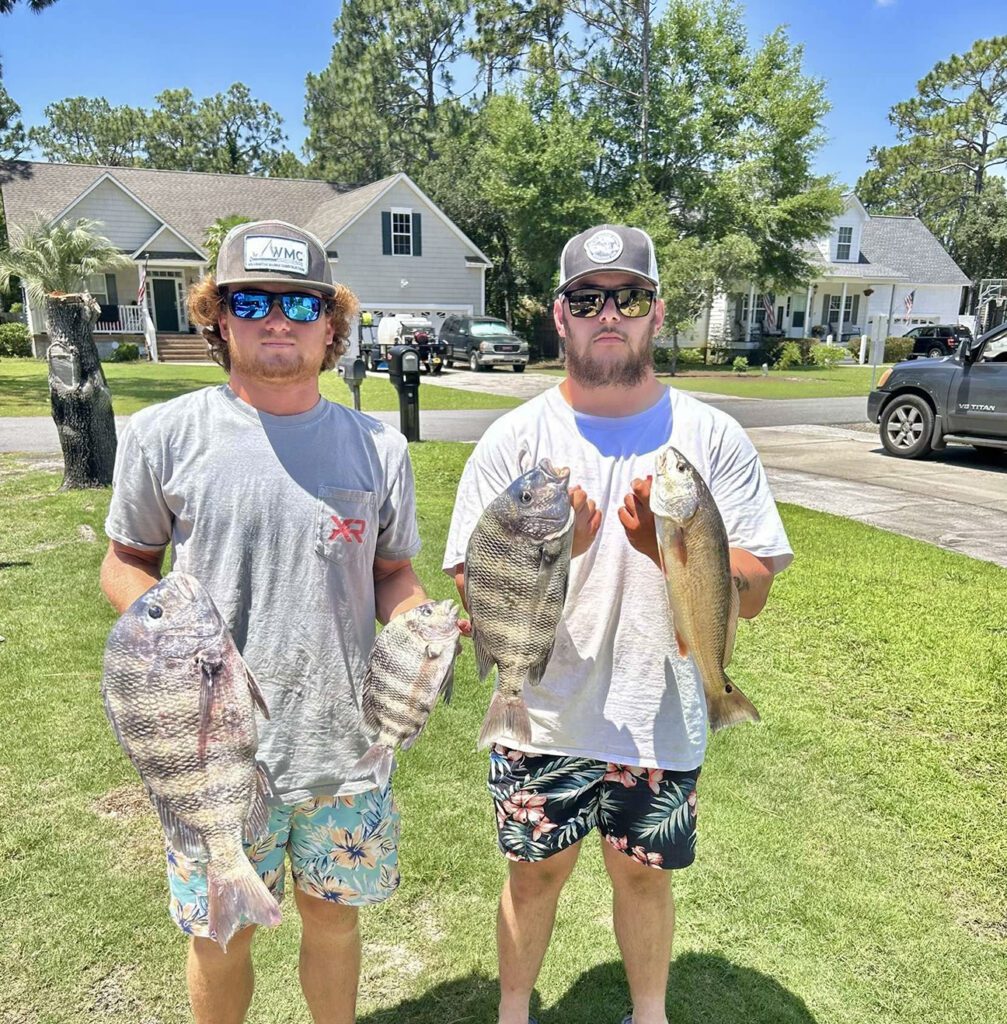Carolina Beach – July 2024
Lewis, of Island Tackle and Hardware, reports that surf anglers have been catching a ton of croakers and plenty of baby sharks. Both are very typical of summertime fishing.
Tarpon hookups have happened on the local piers, with some tarpon also being spotted by the nearshore anglers.
Inshore anglers have had success with scattered red drum, black drum, a few trout, and sheepshead.
A ton of flounder are both in the Cape Fear River and the ICW.
Off the beach, anglers are catching a mix of spanish mackerel and kings while trolling live bait or spoons.
The deeper bottom areas are holding plenty of vermilion snapper and amberjacks.
Christian, of Seahawk Inshore Fishing Charters, reports that anglers are seeing a mixed bag of red drum, scattered black drum, and a few speckled trout.
Red drum have mostly come off live mud minnows or live/cut menhaden. The reds are scattered all over now and in their summertime patterns. Most of these fish are 17-19”, with some reaching into the upper and over-slot range. Anglers are having success targeting them along marsh edges and shell points, with tides not being much of a factor.
Black drum are being caught with shrimp and fiddler crabs. The black drum are hard to find, though, due to the croakers and pinfish tearing up baits, but when they are found, some quality fish are in the mix.
Anglers are still catching a trout or two with live bait while fishing for red drum. If you want to target trout specifically, the best bet would be to fish artificials really early in the morning around creek mouths and tide seams. Moving tide and current is key for the trout bite.

Joe Botterio and Jack Kadnar, of Wilmington, found these sheepshead and red drum in the Carolina Beach area using fiddler crabs.
Tommy, of Mungo Fishing Charters, reports that anglers continue to catch red drum by targeting shoreline banks with mud minnows, menhaden, and dead shrimp.
The occasional speckled trout is being caught when fishing over areas of hard structure such as rocks and oyster bars. Topwater plugs and soft plastics have produced most of the trout bite. Anglers fishing topwaters will do best fishing the cooler early morning hours before the sun gets high.
Black drum are around and can be caught with Carolina-rigged dead shrimp. Just know that the trash fish species are out in full force now, so this fishery requires a lot of patience.
Mason, of Grand Slam Fishing Charters, reports that fish, in general, are scattered in the warm waters and natural baits are best.
Red drum have been the main target, with these fish preferring small menhaden over anything else. Most of the reds are in the 14-25” range, and they’re holding around points or oyster bars with current. Summertime efforts usually require a bunch of moving around from spot to spot, and sometimes that’s as short as 10-15 minutes before heading to another area.
Plenty of flounder are around these same areas and are hitting live baits.
Scattered speckled trout are being caught when targeting areas closer to the ocean. Live menhaden or live shrimp have enticed bites, though shrimp is tough to keep on the line with the trash fish species around.
Sheepshead are around docks and spoil islands in the Cape Fear River. The best tactic has been fiddler crabs or mud crabs.
Tony, of Reel Teal Charters, reports that red drum action has been pretty steady inshore. Most of these fish are just under-slot and lower-slot fish. With not a bunch of finger mullet around yet, Carolina rigs with smaller menhaden are the best bet. Structure (docks and oyster rocks) in both the ICW and Cape Fear River are holding the reds, and efforts in the river are also seeing a bunch of flounder hitting the same live bait offerings. Artificial baits are getting in on the action, too, with smaller (3-4”) Z-Man soft plastics rigged on lightweight (3/16 oz.) Z-Man Eye Strike jig heads as a favorite setup.
Speckled trout aren’t really being active now that the water temperatures have warmed. Anglers targeting them will do best by getting out early and focusing on the low-light hours.
Off the beach, spanish mackerel are around as they usually are, and they’re mostly being found around the inlets or along the beachfronts.

Haley Metzger, of Wilmington, hooked this sheepshead while fishing in the Cape Fear River using a fiddler crab.
Rod, of OnMyWay Guide Service, reports that the summertime king mackerel bite has been scattered anywhere from the beach out to 30 miles. Numbers-wise, the bite has been a little more consistent over the deeper structures.
Spanish mackerel fishing has been good out along the beaches.
The nearshore mahi are starting to show up now that water temperatures are warm everywhere. Locations from 25-40 miles can see the mahi pop up at anytime, many times while bottom fishing or targeting other species.
Bottom fishing stays consistent even with gag grouper now closed. Pinkies, triggerfish, grunts, vermilion snapper, and some black sea bass all make great options for bringing a meal home.
The one-day American red snapper season was announced for July 12. Take advantage of this by targeting ledges in the 25-35 mile area. The reds are absolutely loaded up out there.
Offshore water temperatures are really hot (over 82 degrees) for this time of year. These high temperatures have the trolling bite hard to pin down, with sailfish and blackfin tuna scattered around.
Jeremiah, of Kure Beach Pier, reports that bottom fishing efforts are producing whiting and some scattered pompano.
Anglers sight-casting with plugs are catching bluefish and a few spanish mackerel.





